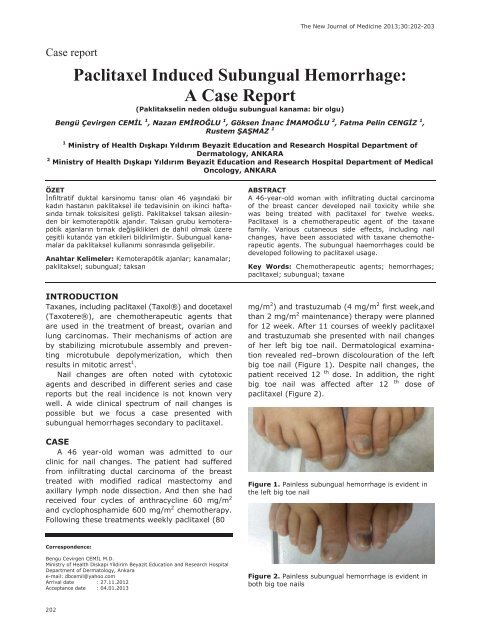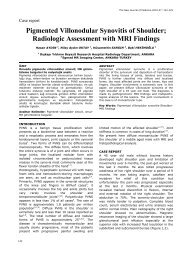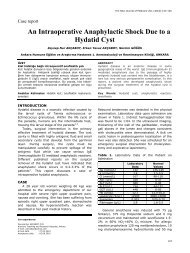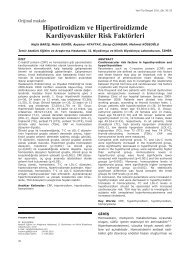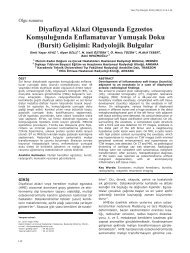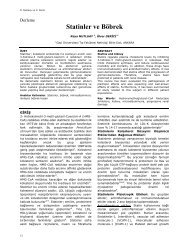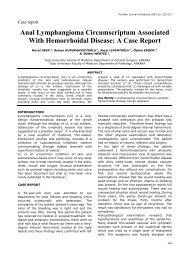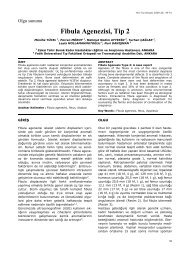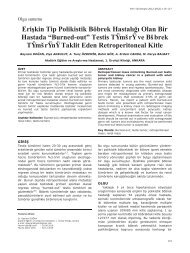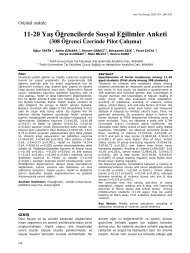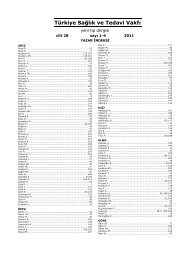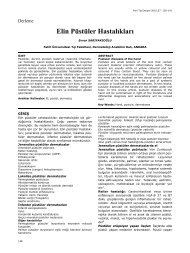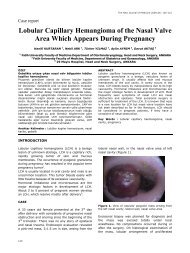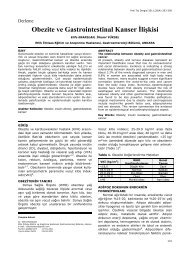Paclitaxel Induced Subungual Hemorrhage: A Case Report
Paclitaxel Induced Subungual Hemorrhage: A Case Report
Paclitaxel Induced Subungual Hemorrhage: A Case Report
Create successful ePaper yourself
Turn your PDF publications into a flip-book with our unique Google optimized e-Paper software.
The New Journal of Medicine 2013;30:202-203<br />
<strong>Case</strong> report<br />
<strong>Paclitaxel</strong> <strong>Induced</strong> <strong>Subungual</strong> <strong>Hemorrhage</strong>:<br />
A <strong>Case</strong> <strong>Report</strong><br />
(Paklitakselin neden olduu subungual kanama: bir olgu)<br />
Bengü Çevirgen CEML 1 , Nazan EMROLU 1 , Göksen nanc MAMOLU 2 , Fatma Pelin CENGZ 1 ,<br />
Rustem AMAZ 1<br />
1 Ministry of Health Dkap Yldrm Beyazit Education and Research Hospital Department of<br />
Dermatology, ANKARA<br />
2 Ministry of Health Dkap Yldrm Beyazit Education and Research Hospital Department of Medical<br />
Oncology, ANKARA<br />
ÖZET<br />
nfiltratif duktal karsinomu tans olan 46 yandaki bir<br />
kadn hastann paklitaksel ile tedavisinin on ikinci haftasnda<br />
trnak toksisitesi geliti. Paklitaksel taksan ailesinden<br />
bir kemoterapötik ajandr. Taksan grubu kemoterapötik<br />
ajanlarn trnak deiiklikleri de dahil olmak üzere<br />
çeitli kutanöz yan etkileri bildirilmitir. <strong>Subungual</strong> kanamalar<br />
da paklitaksel kullanm sonrasnda geliebilir.<br />
Anahtar Kelimeler: Kemoterapötik ajanlar; kanamalar;<br />
paklitaksel; subungual; taksan<br />
ABSTRACT<br />
A 46-year-old woman with infiltrating ductal carcinoma<br />
of the breast cancer developed nail toxicity while she<br />
was being treated with paclitaxel for twelve weeks.<br />
<strong>Paclitaxel</strong> is a chemotherapeutic agent of the taxane<br />
family. Various cutaneous side effects, including nail<br />
changes, have been associated with taxane chemotherapeutic<br />
agents. The subungual haemorrhages could be<br />
developed following to paclitaxel usage.<br />
Key Words: Chemotherapeutic agents; hemorrhages;<br />
paclitaxel; subungual; taxane<br />
INTRODUCTION<br />
Taxanes, including paclitaxel (Taxol®) and docetaxel<br />
(Taxotere®), are chemotherapeutic agents that<br />
are used in the treatment of breast, ovarian and<br />
lung carcinomas. Their mechanisms of action are<br />
by stabilizing microtubule assembly and preventing<br />
microtubule depolymerization, which then<br />
results in mitotic arrest 1 .<br />
Nail changes are often noted with cytotoxic<br />
agents and described in different series and case<br />
reports but the real incidence is not known very<br />
well. A wide clinical spectrum of nail changes is<br />
possible but we focus a case presented with<br />
subungual hemorrhages secondary to paclitaxel.<br />
CASE<br />
A 46 year-old woman was admitted to our<br />
clinic for nail changes. The patient had suffered<br />
from infiltrating ductal carcinoma of the breast<br />
treated with modified radical mastectomy and<br />
axillary lymph node dissection. And then she had<br />
received four cycles of anthracycline 60 mg/m 2<br />
and cyclophosphamide 600 mg/m 2 chemotherapy.<br />
Following these treatments weekly paclitaxel (80<br />
mg/m 2 ) and trastuzumab (4 mg/m 2 first week,and<br />
than 2 mg/m 2 maintenance) therapy were planned<br />
for 12 week. After 11 courses of weekly paclitaxel<br />
and trastuzumab she presented with nail changes<br />
of her left big toe nail. Dermatological examination<br />
revealed red–brown discolouration of the left<br />
big toe nail (Figure 1). Despite nail changes, the<br />
patient received 12 th dose. In addition, the right<br />
big toe nail was affected after 12<br />
th dose of<br />
paclitaxel (Figure 2).<br />
Figure 1. Painless subungual hemorrhage is evident in<br />
the left big toe nail<br />
Correspondence:<br />
Bengu Cevirgen CEML M.D.<br />
Ministry of Health Diskapi Yildirim Beyazit Education and Research Hospital<br />
Department of Dermatology, Ankara<br />
e-mail: dbcemil@yahoo.com<br />
Arrival date : 27.11.2012<br />
Acceptance date : 04.01.2013<br />
Figure 2. Painless subungual hemorrhage is evident in<br />
both big toe nails<br />
202
B. evirgen Cemil et al.<br />
There was no pain on her both toes. At 6 months<br />
after completion of chemotherapy, residual<br />
hyperpigmentation has also remained.<br />
DISCUSSION<br />
<strong>Paclitaxel</strong> belongs to the taxane group of<br />
antineoplastic agents. The taxanes were<br />
introduced in the late 1980s. Since then it has<br />
proved that taxanes were effective in the<br />
treatment of a variety of solid tumors including<br />
breast, ovarian, lung and bladder cancers 2 .<br />
Taxanes exert their cytotoxic effect by<br />
reversibly binding the -subunit of tubulin, thereby<br />
inducing tubulin polymerization and inhibiting<br />
microtubule depolymerization 3,4 . Nail changes are<br />
a common and well-known side-effect of many<br />
antineoplastic drugs, especially methotrexate, 5-<br />
fluorouracil, mitoxantrone, etoposide, and<br />
doxorubicin 5,6 . In addition, it has previously been<br />
reported that antineplastic drugs cause reactions<br />
such as onycholysis, pigmentation, bands,<br />
thickening or thinning of the nail bed, and nail<br />
shedding 7 .<br />
<strong>Paclitaxel</strong> usage may cause hypersensitivity<br />
reactions 8 and radiation recall dermatitis resulting<br />
in extensive desquamation and cutaneous necrosis 9<br />
which are occasionally observed. A generalized<br />
pustular reaction secondary to paclitaxel treatment<br />
has been also reported 10 . The most frequent skin<br />
reaction to paclitaxel is a complete sudden<br />
alopecia, reversible when the drug is discontinued 11 .<br />
Nail abnormalities include different clinical<br />
manifestations such as onycholysis, subungual<br />
hemorrhages and abscesses with secondary<br />
pigmentation and less frequently Beau’s lines and<br />
acute paronychia 3 . These paclitaxel-induced nail<br />
abnormalities suggest that this drug not only is<br />
toxic to the nail matrix and nail bed keratinocytes<br />
but also may affect the vascularization of the nail<br />
unit structures 6 .<br />
The mechanism of how paclitaxel induces the<br />
observed nail abnormalities remains unclear 5 .<br />
Possible explanations for subungual hematoma<br />
and hemorrhagic onycholysis are the taxaneinduced<br />
thrombocytopenia and vascular<br />
abnormalities 3 . Premedication with steroids and<br />
antihistaminics prevents fluid retention and acute<br />
hypersensitivity reactions, like flushing, dyspnea<br />
or hypotension, but do not seem to protect<br />
against skin toxicity 12,13 .<br />
Our patient developed painless subungual<br />
hemorrhages on only big toe without abcess. In<br />
addition, subungual hemorrhage showed firstly on<br />
the left big toe and then fifteen days later it<br />
revealed on the right big toe. After paclitaxel<br />
treatment had been finished, subungual hemorrhages<br />
resolved without using any medication.<br />
<strong>Subungual</strong> haemorrhages due to taxanes may,<br />
in fact, be painful or not, and associated or not<br />
with purulent discharge in different patients. The<br />
variation in nail symptom severity may be related<br />
to drug dosage 14 , to dosing interval 15 and to the<br />
individual patient’s susceptibility. Flory et al.<br />
reported that the occurrence and severity of nail<br />
changes in their series of four patients were not<br />
related to drug dosage 5,15 .<br />
In conclusion, paclitaxel is used for cancer<br />
therapy that can affect the nail unit. <strong>Subungual</strong><br />
haemorrhages could be associated with paclitaxel.<br />
Clinicians should recognize the different spectrum<br />
of skin and nail changes induced by paclitaxel, and<br />
patients should be informed of this distressing<br />
side-effect.<br />
Confinct of interest statement none declared.<br />
REFERENCES<br />
1. Uyttendaele H, Geyer A, Scher RK. Drugs and nails. J Eur Acad<br />
Dermatol Venereol 2004;18:124-5.<br />
2. Crown J, O'Leary M. The taxanes: an update. Lancet 2000;<br />
355:1176-8.<br />
3. Minisini AM, Tosti A, Sobrero AF, Mansutti M, Piraccini BM, Sacco<br />
C, et al. Taxane-induced nail changes: incidence, clinical presentation and<br />
outcome. Ann Oncol 2003;14:333-7.<br />
4. Rowinsky EK, Tolcher AW. Antimicrotubule agents. In De Vita VT<br />
Jr, Hellman S, Rosenberg SA (eds): Cancer: Principles and Practice of<br />
Oncology, 6th edition. Philadelphia, PA: Lippincott Williams & Wilkins 2001;<br />
431–47.<br />
5. Ghetti E, Piraccini BM, Tosti A. Onycholysis and subungual<br />
haemorrhages secondary to systemic chemotherapy (paclitaxel). J Eur Acad<br />
Dermatol Venereol 2003;17:459-60.<br />
6. Hussain S, Anderson DN, Salvatti ME, Adamson B, McManus M,<br />
Braverman AS. Onycholysis as a complication of systemic chemotherapy:<br />
report of five cases associated with prolonged weekly paclitaxel therapy and<br />
review of the literature. Cancer 2000;88:2367-71.<br />
7. Daniel CR 3rd, Scher RK. Nail changes secondary to systemic<br />
drugs or ingestants. J Am Acad Dermatol 1984;10:250-8.<br />
8. Young PC, Montemarano AD, Lee N, Sau P, Weiss RB, James WD.<br />
Hypersensitivity to paclitaxel manifested as a bullous fixed drug eruption. J<br />
Am Acad Dermatol 1996;34:313-4.<br />
9. Yeo W, Leung SF, Johnson PJ. Radiation-recall dermatitis with<br />
docetaxel: establishment of a requisite radiation threshold. Eur J Cancer<br />
1997;33:698-9.<br />
10. Weinberg JM, Egan CL, Tangoren IA, Li LJ, Laughinghouse KA,<br />
Guzzo CA. Generalized pustular dermatosis following paclitaxel therapy. Int<br />
J Dermatol 1997;36:559-60.<br />
11. Almagro M, Pozo JD, Garcia J, Vasquez A, Fonseca E. Nail<br />
alterations secondary to pactitaxel [corrected] therapy. Eur J Dermatol<br />
2000;10:146-7.<br />
12. Correia O, Azevedo C, Pinto Ferreira E, Braga Cruz F, Polónia J.<br />
Nail changes secondary to docetaxel (Taxotere). Dermatology 1999;198:<br />
288-90.<br />
13. Piccart MJ, Klijn J, Paridaens R, Nooij M, Mauriac L, Coleman R, et<br />
al. Corticosteroids significantly delay the onset of docetaxel-induced fluid<br />
retention: final results of a randomized study of the European Organization<br />
for Research and Treatment of Cancer Investigational Drug Branch for<br />
Breast Cancer. J Clin Oncol 1997;15:3149-55.<br />
14. Lüftner D, Flath B, Akrivakis C, Schweigert M, Prinz B,<br />
Mergenthaler HG, et al. Dose-intensified weekly paclitaxel induces multiple<br />
nail disorders. Ann Oncol 1998;9:1139-40.<br />
15. Flory SM, Solimando DA Jr, Webster GF, Dunton CJ, Neufeld JM,<br />
Haffey MB. Onycholysis associated with weekly administration of paclitaxel.<br />
Ann Pharmacother 1999;33:584-6.<br />
203


